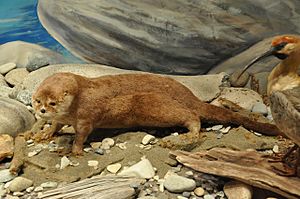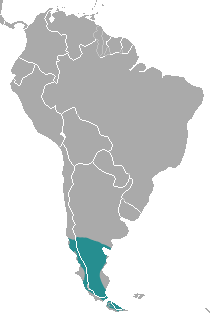Southern river otter facts for kids
Quick facts for kids Southern river otter |
|
|---|---|
 |
|
| Conservation status | |
| Scientific classification | |
| Genus: |
Lontra
|
| Species: |
provocax
|
 |
|
| Southern river otter range | |
The southern river otter (Lontra provocax) is a special type of otter that lives in Chile and Argentina. These playful animals can be found in both salty ocean water and freshwater places like rivers and lakes. Sadly, the southern river otter is an endangered species, which means there are not many left in the wild. They are in danger because of poaching (illegal hunting), water pollution, and losing their homes.
Contents
About the Southern River Otter
Southern river otters are part of the weasel family. They are known for their sleek bodies and strong tails. These otters are excellent swimmers and spend a lot of time in the water. They have webbed feet that help them move fast in rivers and lakes. Their fur is thick and waterproof, which keeps them warm even in cold water.
Where Southern River Otters Live
Southern river otters live in parts of South America. You can find them in the southern areas of Chile and Argentina. They like places with plenty of water and cover. This includes rivers, lakes, and even coastal areas. They often build their dens along riverbanks or in rocky shores. These dens are safe places for them to rest and raise their young.
What Southern River Otters Eat
Southern river otters are carnivores, which means they eat meat. Their diet mainly consists of fish, crabs, and other small water animals. They are skilled hunters and use their sharp teeth to catch their prey. Sometimes, they might also eat birds or small mammals if they can catch them. They play an important role in their ecosystem by helping to control the populations of the animals they eat.
Why Southern River Otters Are in Danger
The southern river otter is an endangered species. This means their numbers are very low. There are a few main reasons why they are in trouble:
- Habitat Loss: People are building more and more, which means the otters are losing their natural homes. Forests are cut down, and wetlands are drained. This leaves otters with fewer places to live and find food.
- Water Pollution: Rivers and lakes where otters live are getting polluted. Chemicals from farms and factories can make the water unsafe. This harms the fish and other animals the otters eat, and it can also make the otters sick.
- Poaching: Sadly, some people still hunt these otters illegally. They might be hunted for their fur or because they are seen as a threat to fish farms. This illegal hunting makes it even harder for their populations to grow.
How We Can Help Southern River Otters
Many groups are working hard to protect southern river otters. Here are some ways people are helping:
- Protecting Habitats: Efforts are being made to save and restore the places where otters live. This includes creating protected areas and planting trees along riverbanks.
- Cleaning Water: People are working to reduce pollution in rivers and lakes. This helps make the water safe for otters and all other wildlife.
- Stopping Poaching: Laws are in place to prevent illegal hunting. Education helps people understand why it's important to protect these animals.
By learning about these amazing creatures, we can all help make sure the southern river otter has a future.
See also
 In Spanish: Huillín para niños
In Spanish: Huillín para niños


